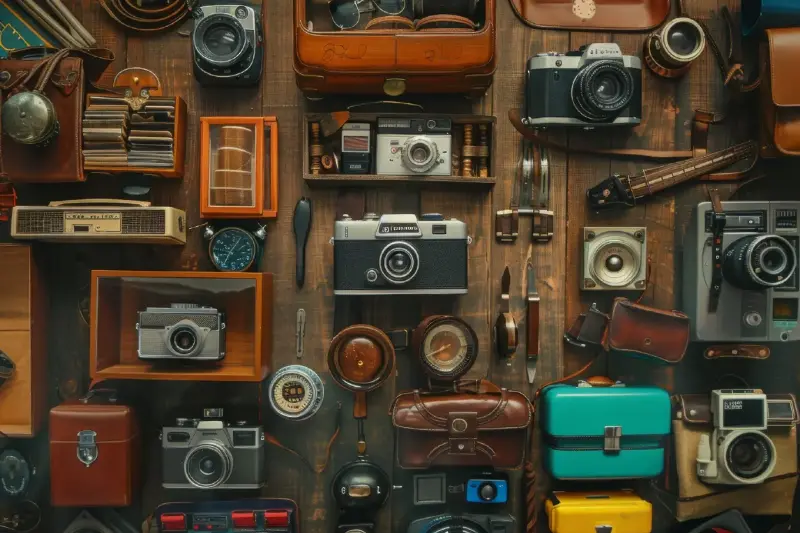From darkrooms to digital feeds, the camera’s journey over nearly two centuries is as captivating as the images it captures. Few inventions have so radically changed how we view the world and ourselves. Behind every snapshot, selfie, and viral video lies a legacy of technological ingenuity and cultural transformation. Whether you’re passionate about photography, curious about history, or just love snapping pics for your socials, exploring the camera’s story reveals much about our connection with technology and the power of pictures in the digital age.

The Early Days: From Pinhole Visions To Portable Wonders
The camera’s tale starts humbly, with the camera obscura—Latin for “dark chamber”. Artists in the Renaissance used these simple devices, which consisted of a darkened room or box with a tiny hole letting light project an outside image onto a wall or surface. While these set-ups weren’t capable of recording images, they became the foundation for what would follow.
Things changed dramatically in 1826, when French inventor Nicéphore Niépce captured the first permanent photograph—titled "View from the Window at Le Gras"—on a pewter plate. The exposure took a staggering eight hours! Just a decade later, Louis Daguerre refined this process, creating the daguerreotype. Cameras now fit atop delicate wooden tripods, and people queued to have their portraits taken. Daguerreotypes offered crisp results, but subjects had to sit very still due to long exposure times. Blinking or sneezing was unfashionable—and disastrous!
The late 19th century revolutionised photography with George Eastman’s launch of the Kodak camera in 1888. Small, portable, and loaded with roll film, the Kodak camera’s slogan—“You press the button, we do the rest”—invited everyday people to snap away and then send their film off for developing. Photography became a hobby, not a profession.
From Silver Halides To Silicon Chips: The Shift To Digital
For over a century, film ruled the world of photography. Chemical coatings on strips of plastic or glass caught fleeting moments, which were then painstakingly developed in darkrooms. The iconic look of black-and-white photos—and later, dazzling Kodachrome colour—defined generations.
But even as film thrived, inventors imagined new frontiers. Enter the charged-coupled device, or CCD, in 1969. British engineer Willard Boyle and Canadian engineer George E. Smith devised a way to convert light into electrical signals. It formed the basis for the first digital sensors. By 1975, Kodak engineer Steven Sasson had built the world’s first true digital camera—a shoebox-sized contraption capturing grainy, black-and-white images on cassette tape. Its meagre 0.01-megapixel sensor might seem laughable today, but it set the stage for a revolution.
Throughout the 1990s and 2000s, digital cameras improved rapidly. Sensor sizes grew, memory cards replaced film, and photographers could see their results instantly. By the mid-2000s, camera phones arrived, sneaking pocket-sized image-makers into everyday life. Today, the smartphone in your pocket is more powerful than early professional digital SLRs, boasting computational photography, AI enhancements, and even 8K video.
Cameras, Culture, And The Democratisation Of Imagery
The rise of the camera has not only shaped what we record, but how we see ourselves and interact with the world. In Victorian times, having your portrait taken was a rare event, often reserved for significant moments. Today, with cameras always at hand, nothing is too mundane to photograph—from the artful latte to the family cat.
Social media platforms, powered by digital imagery, have created entirely new ways to share experiences. Instagram, Snapchat, and TikTok thrive on instant visual communication. The all-important “selfie” became Oxford Dictionaries’ word of the year in 2013, epitomising a culture where self-representation and sharing are always within reach. Consider this: every two minutes, more pictures are taken globally than existed in all of the 19th century.
Cameras have empowered citizen journalists and transformed news reporting. World-changing events, from natural disasters to political protests, are now often seen first through the lens of someone’s phone. These digital witnesses have brought about greater transparency, accountability, and awareness in our global society.

The Artistry And Science Behind Every Pixel
While technology has made photography accessible, it has also deepened its artistry and complexity. Early photographers painstakingly mixed chemicals and plotted exposure times, but today’s image-makers have a universe of creative tools at their disposal. Computational photography lets you adjust focus after the fact, blend multiple exposures for perfect lighting, or erase distracting objects with a swipe. Filters, editing apps, and digital manipulation have made it easier than ever to turn raw captures into polished masterpieces.
Surprisingly, your smartphone camera is not just a shrinking of old camera tech. Inside, tiny sensors and micro-lenses work in harmony with sophisticated software that interprets scenes, balances colours, and even recognises faces. The process of translating reality into pixels involves advanced mathematics and AI, ensuring you get a great picture—even in tricky lighting.
Yet, despite its digital wizardry, the camera remains a tool for creativity and expression. The heart of photography beats the same as always: a desire to capture, remember, and share the beauty and reality around us.
The Camera’s Ongoing Evolution: Looking To The Future
Where does the camera go from here? Technology keeps pushing boundaries. Mirrorless cameras are replacing bulky SLRs, making professional-quality photography lighter and faster. Artificial intelligence is helping cameras “see” in dark conditions, stabilise images, and suggest the best shot.
Virtual reality, 360-degree cameras, and even drone photography are opening fresh perspectives, letting people experience moments and places like never before. In the coming years, we may see cameras woven into smart glasses or other wearables, making their presence almost invisible—but their impact more profound.
The story from pictures to pixels is one of constant curiosity, innovation, and cultural resonance. Whether you are photographing loved ones, documenting history, or sharing your latest adventure online, you are part of a long tradition that continues to shape not just technology, but the fabric of human experience.
